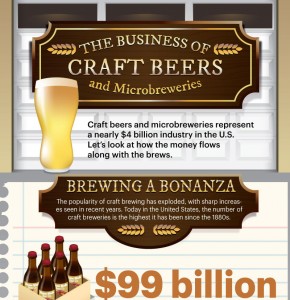The Business of Craft Beers and Microbreweries
Craft beers and microbreweries represent a nearly $4 billion industry in the U.S. Let’s look at how the money flows along with the brews.
Brewing a Bonanza
The popularity of craft brewing has exploded, with sharp increases seen in recent years. Today in the United States, the number of craft breweries is the highest it has been since the 1880s.
$99 billion
Total sales of beer in the U.S. in 2012
200,028,520
Total barrel of beers sold in the U.S. in 2012
10.2%
Market share of craft beer
13 million
Barrels of craft beer produced in the U.S. in 2012, up more than 71% from 2006
$3.9 billion
2013 spending on craft beer
2,403
Craft breweries operating in 2012 (the most since the 1880s)
Craft Beer Near You
Never fear — the surge of craft breweries means you don’t have to put up with mass-produced, watered-down beer. Raise a mug to the brewery-est states in the U.S.:
Total craft breweries by state
Alabama 10
Alaska 22
Arizona 44
Arkansas 10
California 316
Colorado 151
Connecticut 21
Delaware 9
Florida 57
Georgia 22
Hawaii 9
Idaho 29
Illinois 67
Indiana 54
Iowa 33
Kansas 19
Kentucky 14
Louisiana 8
Maine 37
Maryland 30
Massachusetts 47
Michigan 122
Minnesota 47
Mississippi 3
Missouri 45
Montana 36
Nebraska 19
Nevada 21
New Hampshire 19
New Jersey 26
New Mexico 27
New York 88
North Carolina 70
North Dakota 4
Ohio 58
Oklahoma 10
Oregon 140
Pennsylvania 102
Rhode Island 8
South Carolina 16
South Dakota 7
Tennessee 30
Texas 84
Utah 16
Vermont 25
Virginia 48
Washington 158
West Virginia 5
Wisconsin 83
Wyoming 15
Want to Try it Yourself?
Homebrewing can be the most cost-effective way to drink good beer over the long haul. Basic beginners’ equipment kits start around $80, and ingredients cost about $25 to $45 per 5-gallon batch.
What you’ll need
Materials:
Fermenter, usually a plastic bucket with a tight-fitting lid
Air lock and stopper to allow CO2 to escape during the process while keeping air out
Thermometer
Racking cane and tubing for transferring beer
Bottles, about 50 12-oz bottles for each 5-gallon batch
Bottle filler to transfer beer into bottles
Bottle capper, a device to clamp bottle caps on bottles
Sanitizing agent and bottle cleaning brush
Stove
Large pot
Cooking spoon
Strainer
Measuring cup
Can opener
Cup or a bowl
Sink
Ice
Ingredients *
3 lbs light dried malt extract
8 oz crushed crystal malt
1 package brewer’s yeast
1 oz Northern Brewer pellet hops
3/8 cup sugar
Any other additions (don’t go crazy until you know what you’re doing)
* Following Instructables recipe
Brewing A Batch
Now that you’ve got your materials and ingredients, you’re ready to become a brewmaster.
Steeping
Use a rolling pin to crush the crystal malt in a plastic bag. Then pour 2 1/2 gallons water into your brew pot, leaving at least 3 inches to the top of the pot. Add your crushed grains. Turn on the heat to medium high and bring the temperature up to 150 to 155 degrees. Turn off the heat and cover the brew for 30 minutes. Use a strainer to remove as much of the spent grain as possible without worrying too much about a few remaining grains.
Boiling
Bring the contents of the brew pot to a boil. Then, remove from heat and stir in the malt extract. Return to heat and again bring to a boil. Once you have a controlled boil, add about 2/3 oz of the hop pellets to the boil and maintain the boil for 60 minutes. Turn off the heat and add the remainder of the hop pellets. Cover and let the newly added hops steep for 10 minutes.
Cooling the wort
Pronounced “wert,” wort is just another name for unfermented beer. Quicker is better when it comes to cooling. Create a cold water bath in the sink to partially submerse the brew pot in.
Pitching the yeast
Pour your cooled wort through your sanitized strainer and funnel into the empty fermentation bottle. You’ll want the total volume in the fermenter to be 2 1/2 gallons. If that means you need to add water, tap is fine. Once the wort is at room temperature, pour half of the yeast package in.
Fermentation
Place the fermenter in a cool, dark place for 7-10 days.
Priming
Boil 3/8 cup of sugar in 1 cup of water for 5 minutes. Cover and let it cool some, then pour into a sanitized container large enough to hold your beer. Now siphon your beer from the fermenter into the bottling container, being careful not to disturb too much sediment at the bottom of the fermenter.
Bottling
You are ready to bottle your beers. Remember to let them age in the bottles in a cool, dark place for 7-10 days.
Enjoy!
Congratulations, you’ve just made your first batch of brew. Now kick back and enjoy.
Sources:
http://blogs.ocweekly.com
http://www.newyorker.com
http://www.instructables.com
https://www.brewersassociation.org
http://www.businessinsider.com







